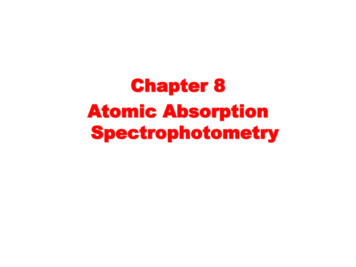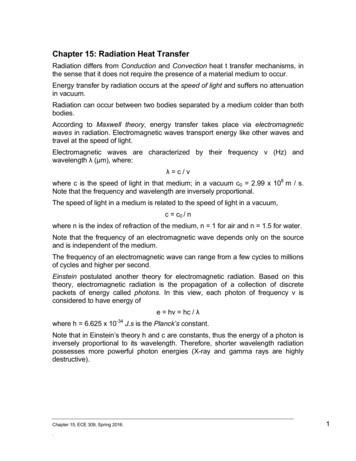
Transcription
The electromagnetic spectrumCESAR’s Booklet
The electromagnetic spectrumThe colours of lightYou have surely seen a rainbow, and you are probably familiar with the explanation to thisphenomenon: In very basic terms, sunlight is refracted as it gets through water droplets suspendedin the Earth’s atmosphere. Because white light is a mixture of six (or seven) different colours, andeach colour is refracted a different angle, the result is that the colours get arranged in a givenorder, from violet to red through blue, green, yellow and orange. We can get the same effect in alaboratory by letting light go through a prism, as shown in Figure 1. This arrangement of colours iswhat we call a spectrum.Figure 1: White light passing through a prism creates a rainbow. (Credit: physics.stackexchange.com)Yet the spectrum of light is not only made of the colours we see with our eyes. There are othercolours that are invisible, although they can be detected with the appropriate devices. Beyond theviolet, we have ultraviolet, X-rays and gamma rays. On the other extreme, beyond the red, wehave infrared and radio. Although we cannot see them, we are familiar with these other types oflight: for example, we use radio waves to transmit music from one station to our car receiver,ultraviolet light from the Sun makes our skin get tanned, X-rays are used by radiography machinesto check if we have a broken bone, or we change channel in our TV device by sending an infraredsignal to it from the remote control.Light as wavesPhysicists describe light as something called electromagnetic radiation or electromagnetic wave.The word radiation means ‘energy that is transported from one spot to another without need ofdirect contact between the two locations’. Light in each of these colours carries a different amountof energy: gamma rays are the most energetic, and radio is the least. Thus, when we observegamma or X-rays from an astronomical object, we know that something really powerful ishappening there.This energy is transported in the form of a wave, and each colour is related to a different wavesize: The more energy the wave carries, the narrower it is –or, in technical terms, the shorter itswavelength. Hence, X-rays have shorter wavelengths than visible-light waves (also called ‘opticalwaves’ in Astronomy), and visible light has shorter wavelengths than radio waves.The Electromagnetic Spectrum2CESAR’s Booklet
Properties of wavesA wave (Figure 2) is a periodic perturbation from an undisturbed or rest state that istransmitted in space. The maximum deviation from this undisturbed state is called theamplitude of the wave, and is a measure of the intensity of the perturbation; the top of thewave is called a crest and the lowest state, a trough.Figure 2: Properties of a wave. (Credit: Pearson Prentice Hall)Waves are characterised by their size, measured as the distance between two equal states;this distance is called the wavelength, λ. The colours of visible light are the way our eyesperceive the different wavelengths.The time it takes for the perturbation to move one wavelength –in other words, to repeatitself–, is called the period of the wave, P. Wavelength and period are related through thespeed of the wave, c, because speed is defined as space travelled per unit time:𝑐 𝜆𝑃(1)The number of complete cycles –the number of times the wave repeats itself– in one secondis called the frequency of the wave, ν. Thus, the frequency is the inverse of the period, and isalso related to the wavelength through the wave speed:𝜐 1 𝑐 𝑃 𝜆(2)It is important to note that the speed of light waves does not depend on the frequency,wavelength or period, but only on the medium the wave is traveling through. However,contrary to other waves like sound or water waves, electromagnetic waves (light) do notactually require a medium to be transmitted through: they can travel through the vacuum. Iflight travels through a vacuum, it has the maximum possible speed –and this speed is thesame for all frequencies of light.The Electromagnetic Spectrum3CESAR’s Booklet
Figure 3 summarises the properties of the electromagnetic spectrum:Figure 3: Properties of the electromagnetic spectrum. (Credit: Wikimedia Commons)The colours of starsThe amount of light of a given colour (or wavelength) that is emitted by a body depends on itstemperature. And since all macroscopic bodies have a temperature above absolute zero, all ofthem emit light, at all times and in all wavelengths. The reason is that they are made ofmicroscopic, electrically charged particles that are constantly in random motion; and Physicsshows that a charged particle in motion emits electromagnetic radiation.Thus, even if you cannot see it with your eyes, everything around you is emitting light: stars andlight bulbs of course, but also your table and chair, your cat, even ice cubes, even you. However,for most everyday objects, the amount of light emitted in the visible range is very low; we see mostof the things around us thanks to the light they reflect, not to the light they emit.Contrary to what everyday experience tells us, though, most of the light emitted by the hottestobjects in the universe has a colour on the ‘blue side’ of the spectrum (violet and ultraviolet), whilethe coolest objects emit most of their light in a colour in the ‘red side’ of the spectrum (infrared andradio). In other words, a blue star is hotter than a red star!The Electromagnetic Spectrum4CESAR’s Booklet
Blackbody radiationThe emission of light from many macroscopic objects, including stars and other astronomicalbodies, can be approximately described by a so-called blackbody curve. A blackbody is anideal object that absorbs all radiation falling upon it, in all frequencies, and that is able to reemit the same amount of energy it absorbs. If we plot the amount of energy radiated by ablackbody as a function of wavelength (or frequency), we get a characteristic distribution thatdepends solely on the temperature of the object.Figure 4: Blackbody curves of different temperatures. (Credit: Wikimedia Commons)As seen in Figure 4, the blackbody curve has a peak at a given wavelength (or frequency),and this peak gets higher as the body’s temperature increases, meaning that the area belowthe curve also gets bigger. This means that the amount of energy radiated by the object alsoincreases; and the opposite: as temperature decreases, the energy output from theblackbody decreases. This behaviour is known as Stefan-Boltzmann’s Law, and it goesmathematically like this:𝐸 𝜎𝑇 !(3)The quantity σ, known as Boltzmann’s constant, has the value:𝜎 5.6704 10!! W m!! K !!In plain words, Stefan-Boltzmann’s Law is telling us that the hotter the object, the moreenergy it radiates.The Electromagnetic Spectrum5CESAR’s Booklet
Also the position of the curve peak depends on the blackbody’s temperature. If thetemperature increases, the peak shifts toward shorter ('bluer’) wavelengths (higherfrequencies), while it will shift toward longer (‘redder’) wavelengths (lower frequencies) as thetemperature decreases. The mathematical relation between the peak wavelength λmax andthe blackbody’s temperature T, known as Wien’s Law, is the following:𝜆!"# 𝑏𝑇(4)where the constant of proportionality b is called Wien’s displacement constant, and its valueis:𝑏 2.8978 10!! m KThe position of the peak is related to the colour of the blackbody: If the curve peaks in theblue or violet end of the visible spectrum, the object will look blue to our eyes; if it peaks inthe red end, it will look red. If it peaks in-between, the amount of light emitted by theblackbody in all visible colours is relatively high, and so our eyes will perceive a mixture of allthose colours; that is why we don’t see any green stars!Hence, what Wien’s Law is telling us is: The hotter the star, the bluer it is.If the blackbody curve peaks outside the visible range of the electromagnetic spectrum, thecolour we see will depend on the amount of light emitted in each frequency (or wavelength)of the visible spectrum: A blackbody radiating most in the ultraviolet will still emit a lot ofenergy in the violet and blue, and thus those objects will be a deep blue colour to our eyes.On the other hand, a blackbody peaking in the infrared will emit very little in the visible range,and hence we will see it black.Figure 5 shows the (approximated) colours of stars of different temperatures.Figure 5: Colours of stars of different temperatures. (Credit: Quora)The Electromagnetic Spectrum6CESAR’s Booklet
Observing across the spectrumBecause astronomical objects emit light in different colours depending on their temperature andthe phenomena that are going on in them, it is important to observe them in different types of lightto fully understand them. As an example, Figure 6 shows the Crab Nebula, a supernova remnantabout 6,000 light-years from Earth, observed by different telescopes that detect different types oflight. Note how the appearance of the nebula changes depending on the wavelengths that areobserved, because they are being emitted by different components or phenomena in this object.The cool gas and dust dominate the emission in the radio and infrared bands, respectively; invisible and ultraviolet light, we see the gas heated and ionised by the central neutron star (all thatis left from a massive star that exploded at the end of its life); and X and gamma-rays reveal theemission from the neutron star itself, which is surrounded by a disk of very hot gas in the X-rayimage.Figure 6: The Crab Nebula observed across the electromagnetic spectrum. (Credits: NASA/ESA/NRAO)In Table 1, you have a list of the temperatures of sources emitting in the different colours of theelectromagnetic spectrum, as well as some examples of these sources.But observing across the full electromagnetic spectrum is not possible from Earth, as theatmosphere blocks most of the invisible light (see Figure 3). For this reason, telescopes observingthe universe in invisible colours (except part of the radio and infrared) must be placed in space.Figure 7 shows the space telescopes operated by ESA, and the part of the electromagneticspectrum they observe.The Electromagnetic Spectrum7CESAR’s Booklet
Table 1: Examples of astronomical sources emitting in each range of the electromagnetic spectrum.Type of radiationTemperatureTypical sourcesGamma-rays 10 KX-rays10 -10 KUltraviolet10 -10 KVisible10 -10 KInfrared10-10 KVery cool starsPlanetsCool clouds of dustRadio 10 KCool clouds of gasThe Cosmic Microwave Background (CMB)Electrons moving in magnetic fields8684634Matter falling into black holesGas in clusters of galaxiesSupernova remnantsStellar coronaeSupernova remnantsVery hot starsStarsHot planets3Adapted from: NASA/Imagine the Universe!Figure 7: ESA’s fleet of telescopes across the electromagnetic spectrum. The sub-millimetre rangecorresponds to the shortest radio waves. (Credit: ESA)The Electromagnetic Spectrum8CESAR’s Booklet
The Electromagnetic Spectrum 7 CESAR’s Booklet Observing across the spectrum Because astronomical objects emit light in different colours depending on their temperature and the phenomena that are going on in them, it is important to observe t










